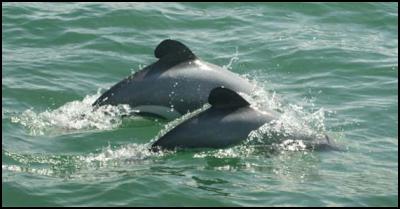Help spot world’s rarest dolphin this summer– Māui's dolphin
Help spot world’s rarest dolphin this summer– Māui's
dolphin
14 December 2015

Surfies, boaties, and beach-goers are asked to spot world’s rarest dolphin.
Māui's dolphin are found off the west coast of North Island in New Zealand are the rarest in the world. They’re found between the Whanganui River mouth in the South and Dargaville in the North putting them in perfect range of the surfing highway.
Conservationists are asking for sightings of Māui's dolphin to help determine the distribution of Māuis dolphins and if possible to allow DOC to collect a DNA sample. Scientists can use a method called DNA fingerprinting in order to distinguish individuals. This way, they may be able to tell if this dolphin has been sighted in the past, improving our knowledge of movement patterns.
DOC keeps a database of all Māui’s dolphin sightings from 1970 to present, and this is available for download by the public.
Māui's dolphins are generally found close to shore in the warmer summer month in groups or pods of several dolphins. They can be seen in water shallower than 20 m, including river mouths, estuaries, harbours and shallow bays, but are also known to range offshore up to 12 nautical miles.
The easiest way to identify the Māui's dolphin is to look for its distinctive rounded “mickey mouse-type” rounded dorsal fin. Their bodies have distinctive grey, white, and black markings and a short snout. The sightings are put on the DOC database and used to help protect these dolphins from deadly fishing gear like set nets and trawling which can kill them.
If you
think you’ve spotted a Māui's dolphin call 0800 DOC HOT
and if possible take a photo. You can also download the WWF
NZ mobile app for a smartphone to report a Māui's
dolphins. On sighting the dolphin/s
record:
• location
• a GPS coordinate if
possible
• take a photograph/video (many mobile phones
have a camera/video recorder built into them – on
smartphones, you can also go into your camera's settings and
turn on geotagging of photos)
• note down any
landmarks, and include them in the photos if
possible
• number of dolphins
• date and time of
sighting
Where possible, remain in the vicinity of the
dolphin/s (but do not chase or harass them). Keep speed to a
minimum and avoid sudden changes in direction. If possible
DOC staff may attempt to make radio or phone contact with
you. On arrival, DOC staff may attempt to take a genetic
sample.
ENDS


 SolarZero Affected Staff: SolarZero Staff Are Demanding Answers After The Company Went Into Liquidation
SolarZero Affected Staff: SolarZero Staff Are Demanding Answers After The Company Went Into Liquidation Tātau Tātau O Te Wairoa: Guidance To Save Local Newspapers Amid NZME Closures
Tātau Tātau O Te Wairoa: Guidance To Save Local Newspapers Amid NZME Closures Commerce Commission: Systemic Breaches Of Consumer Law Lead To $1.5million Fine For Kiwibank
Commerce Commission: Systemic Breaches Of Consumer Law Lead To $1.5million Fine For Kiwibank SolarZero: SolarZero Limited (in Liquidation) - Important Business Update
SolarZero: SolarZero Limited (in Liquidation) - Important Business Update Science Media Centre: Cyclone Gabrielle's Impacts On NZ's Ecosystems - Expert Reaction
Science Media Centre: Cyclone Gabrielle's Impacts On NZ's Ecosystems - Expert Reaction RNZ: Parts Of Power System Could Be Out For 36 Hours In Event Of Extreme Solar Storm
RNZ: Parts Of Power System Could Be Out For 36 Hours In Event Of Extreme Solar Storm



